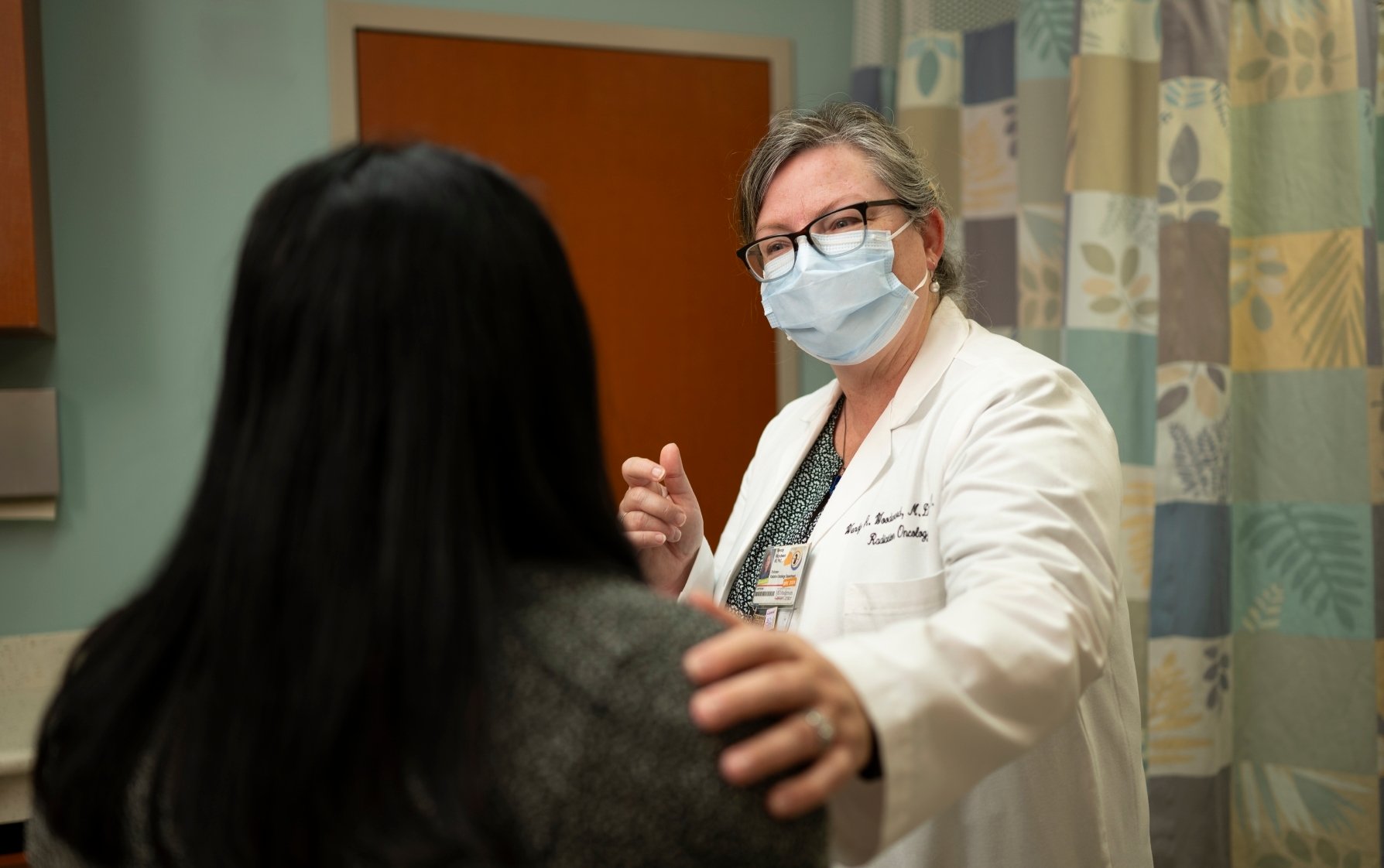- Diseases
- Acoustic Neuroma (14)
- Adrenal Gland Tumor (26)
- Anal Cancer (68)
- Anemia (2)
- Appendix Cancer (16)
- Bile Duct Cancer (26)
- Bladder Cancer (72)
- Brain Metastases (28)
- Brain Tumor (232)
- Breast Cancer (716)
- Breast Implant-Associated Anaplastic Large Cell Lymphoma (2)
- Cancer of Unknown Primary (4)
- Carcinoid Tumor (8)
- Cervical Cancer (160)
- Colon Cancer (166)
- Colorectal Cancer (118)
- Endocrine Tumor (4)
- Esophageal Cancer (44)
- Eye Cancer (36)
- Fallopian Tube Cancer (8)
- Germ Cell Tumor (4)
- Gestational Trophoblastic Disease (2)
- Head and Neck Cancer (12)
- Kidney Cancer (128)
- Leukemia (342)
- Liver Cancer (50)
- Lung Cancer (286)
- Lymphoma (278)
- Mesothelioma (14)
- Metastasis (30)
- Multiple Myeloma (100)
- Myelodysplastic Syndrome (60)
- Myeloproliferative Neoplasm (6)
- Neuroendocrine Tumors (16)
- Oral Cancer (100)
- Ovarian Cancer (172)
- Pancreatic Cancer (160)
- Parathyroid Disease (2)
- Penile Cancer (14)
- Pituitary Tumor (6)
- Prostate Cancer (146)
- Rectal Cancer (58)
- Renal Medullary Carcinoma (6)
- Salivary Gland Cancer (14)
- Sarcoma (240)
- Skin Cancer (298)
- Skull Base Tumors (56)
- Spinal Tumor (12)
- Stomach Cancer (64)
- Testicular Cancer (28)
- Throat Cancer (92)
- Thymoma (6)
- Thyroid Cancer (100)
- Tonsil Cancer (30)
- Uterine Cancer (82)
- Vaginal Cancer (18)
- Vulvar Cancer (20)
- Cancer Topic
- Adolescent and Young Adult Cancer Issues (20)
- Advance Care Planning (10)
- Biostatistics (2)
- Blood Donation (18)
- Bone Health (8)
- COVID-19 (362)
- Cancer Recurrence (120)
- Childhood Cancer Issues (120)
- Clinical Trials (632)
- Complementary Integrative Medicine (22)
- Cytogenetics (2)
- DNA Methylation (4)
- Diagnosis (232)
- Epigenetics (6)
- Fertility (62)
- Follow-up Guidelines (2)
- Health Disparities (14)
- Hereditary Cancer Syndromes (128)
- Immunology (18)
- Li-Fraumeni Syndrome (10)
- Mental Health (116)
- Molecular Diagnostics (8)
- Pain Management (62)
- Palliative Care (8)
- Pathology (10)
- Physical Therapy (18)
- Pregnancy (18)
- Prevention (920)
- Research (392)
- Second Opinion (74)
- Sexuality (16)
- Side Effects (604)
- Sleep Disorders (10)
- Stem Cell Transplantation Cellular Therapy (216)
- Support (402)
- Survivorship (322)
- Symptoms (182)
- Treatment (1786)
Ringing the bell marks a milestone in cancer treatment
4 minute read | Published October 28, 2019
Medically Reviewed | Last reviewed by an MD Anderson Cancer Center medical professional on October 28, 2019
For Bridget Reeves, ringing the bell after completing six months of chemotherapy for breast cancer was “a big deal.”
Soldiering through nausea, exhaustion and nerve damage, she’d juggled chemo and her job as an MD Anderson clinical studies coordinator for 13 weeks before finally taking leave when she could no longer feel her foot on the brake pedal driving home.
Even through the worst of it, the sound of other patients ringing the bell never failed to lift her spirits.
“I’d think, ‘Yeah, that’s going to be me. I’m almost there,’” she recalls.
When her turn came to ring the bell, she felt both relief that the day-to-day grind of chemotherapy was over and a sense of accomplishment that she was still standing.
“I finally felt I could celebrate something,” she says. “I could celebrate I made it through this part.”
A tradition with MD Anderson roots
Nowadays it seems nearly every cancer facility has bells that patients can ring to mark the end of treatment. But it’s thought that the tradition began at MD Anderson in 1996.
A rear admiral in the U.S. Navy, Irve Le Moyne, was undergoing radiation therapy for head and neck cancer and told his doctor, Kian Ang, M.D., Ph.D., that he planned to follow a Navy tradition of ringing a bell to signify “when the job was done.” He brought a brass bell to his last treatment, rang it several times and left it as a donation. It was mounted on a wall plaque in the Main Building’s Radiation Treatment Center with the inscription:
Ringing Out
Ring this bell
Three times well
Its toll to clearly say,
My treatment’s done
This course is run
And I am on my way!
— Irve Le Moyne
Ringing the bell caught on quickly with other head and neck patients completing radiation treatments, and bells began popping up around MD Anderson for other treatments, from chemotherapy to stem cell transplantation to physical therapy.
In addition to many of the clinics on our Texas Medical Center Campus, the bells have spread to our suburban locations. In our new League City and West Houston facilities, the bells are on walls with an eye-catching background of colored ribbons representing different kinds of cancer.
Celebrating a cancer treatment milestone
Many patients are joined by friends and family for their last day of treatment and the bell ringing.
Once a patient and 12 guests showed up for the bell ringing in evening gowns, then followed up with a formal dinner at home.
Donna Nicodemus, an MD Anderson facilities customer advocate who was treated for uterine cancer, recalls focusing on the bell as a light at the end of the tunnel.
“I wasn’t going to miss it for anything,” she says.
So it meant a lot to her when half a dozen co-workers, as well as her mother and sister, turned out to watch her ring the bell.
“They were my support group when it felt like every bone in my body was going to break,” she says. “If it hadn’t been for them giving me pep talks, I don’t know how I would have gotten through it.”
When families and friends can’t make it in person, it’s not unusual for them to listen in or watch via cellphone.
George Brownfield, an MD Anderson senior systems analyst treated for throat cancer, rang the bell four years ago and still has the video, taken by a co-worker, on his phone. It marks a milestone of sorts.
“You can’t understand how good it feels to ring that bell when you’re done,” he says.
But in many cases not totally done.
Ringing the bell doesn’t always mark the end of cancer treatment
Some patients, including Brownfield, Nicodemus and Reeves, end up ringing the bell more than once because their treatment involves some combination of surgery, radiation and chemotherapy. Other patients’ cancer may return and require additional treatment.
Maria Dungler, director of Creative Communications, felt very differently on the two occasions she rang the bell.
In her case, the radiation treatments she received for breast cancer had few side effects. She was able to enjoy the support of co-workers who joined her for photos and video even as she tried to keep a lid on the bell celebration out of respect for patients not yet finished with treatments and those who might never be finished.
The chemotherapy that followed turned out to be considerably rougher, and the ceremony this time around took on a different meaning. Exhausted, she kept it low-key, with only her husband in attendance.
“It was a celebration, but it was more about a powerful sense of relief,” she says. “I was celebrating my staying power and getting through the hardest thing I’d ever done. But I was mostly just relieved to be done with it and getting out of there.”
For her part, Reeves drew strength from ringing the bell a second time.
Three weeks after her chemotherapy ended, Reeves underwent surgery as planned, followed by six weeks of radiation (and another bell ringing). But knowing what was coming – and not knowing what might come further down the line – didn’t diminish the power of ringing the bell.
“It’s like, wow, I’m done with that,” she says. “Now I’m ready for the next step.”
A longer version of this story originally appeared in Messenger, MD Anderson’s quarterly publication for employees, volunteers, retirees and their families.
Request an appointment at MD Anderson online or by calling 1-844-740-9959.

I wasn’t going to miss it for anything.
Donna Nicodemus
Survivor & Facilities Customer Advocate





